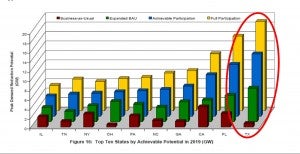Don’t Turn The Lights Off On Demand Response

If Texas Legislators want to make sure the lights stay on this summer, they have a great opportunity to do so tomorrow, April 9, 2013, while saving electric customers money. There are two critical bills being considered at the legislature in Texas that would expand the use of demand response, a tool that allows customers to voluntarily reduce peak, or high, electricity use and receive a payment for doing so in response to a signal from their energy provider. We need to take advantage of tools like demand response to alleviate the pressures facing the Texas electric grid, what EDF refers to as the ‘Texas Energy Crunch,’ which include a shrinking water supply, growing population and rising summer temperatures.
Demand response has been identified by numerous experts as a key component to a reliable electric grid in Texas, and Tuesday’s Senate Business & Commerce Committee hearing at 8 am represents a great opportunity for the legislature to help meet future energy needs while providing direct benefits to customers and reducing water usage.
Demand response is critical to keeping the Texas electric grid humming. According to a comprehensive report on the Electric Reliability Council of Texas (ERCOT) reliability from the Brattle Group, “the energy-only market will not dependably support ERCOT’s current reliability target until sufficient demand response penetration is achieved.” Demand response can be deployed in a matter of months, while it usually takes two to five years to build a natural gas power plant, even after all the permitting and financing is completed. At the same time, demand response provides financial incentives; in the mid-Atlantic region, where demand response plays a critical role in the electric market, customers were paid a total of $330 million last year. At the same time, according to the grid operator for the region, PJM, demand response actually lowers overall energy system costs by bringing more competitive resources into the market. During the summer of 2012, PJM estimates this effect saved all customers around $650 million.
Senate Bill 1280 by State Senator Kirk Watson would guarantee that the Texas electric grid has enough resources to avoid the kind of blackouts we saw in 2011, and that some fear may return this year if we have another hot summer. The concern is that there is currently a “gap” between the amount of resources ERCOT expects to have this summer, next summer and into the future, and the resources they believe they need to maintain a reliable electric grid at historical levels. Senator Watson’s bill would authorize ERCOT to use demand response to fill that gap, providing grid operators with a key tool to keep the lights on during the hottest parts of the summer.
Business and Commerce Committee Chairman John Carona has long been a champion of demand response as well, and this session is no exception. His Senate Bill 1351 would require ERCOT to allow all customers to participate directly in the competitive market for electricity with conventional power plants. In other parts of the country with competitive markets, this has been an extremely effective approach to growing demand response. Currently, only larger customers like big companies can participate in some of Texas’ competitive markets. However, ERCOT has just begun to develop a small pilot program that would allow participation from smaller customers like homeowners who are willing to run their pool pumps at night instead of during the day or grocery stores that can pre-cool spaces to reduce cooling needs during peak times. Meanwhile, companies like TXU and Reliant have offered innovative pilot programs for their smaller customers including time of use rates and smart thermostats.
All of these efforts are critical, however most experts agree that demand response programs for residential and small business customers are still a very small part of the marketplace, despite the fact that these customers account for 72 percent of peak demand during the summer. Chairman Carona’s bill would create a stronger underlying framework for the development of a transparent and flexible market for demand response programs in Texas.
This session has been surprisingly low-key on energy issues such as this one, but with the crippling drought and the prospect of another hot summer leading to rolling blackouts, legislators should give this issue the attention it deserves. Guidance from the Public Utility Commission on demand response has been murky and inconsistent at best, even as they focus on ideas that ERCOT projects such as an “operating reserves” proposal from GDF SUEZ could cost as much as $2 billion, and will not ensure reliability in the electric grid.
At the same time, while ERCOT staff has worked to move forward on several demand response issues, the stakeholder process – in which current stakeholders help to develop new market rules – has slowed down the creation of new programs for potential competitors. This situation demonstrates exactly why high-level policy guidance is needed: stakeholders can’t be expected to develop effective rules for potential competitors. We hope that the committee gives both bills serious consideration, and passes them quickly so that we can make sure the lights don’t go out on demand response in Texas, because if they do, the lights may go out on customers too.










